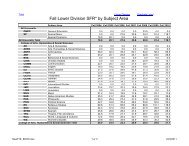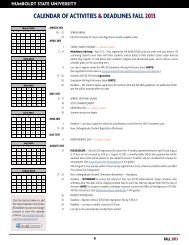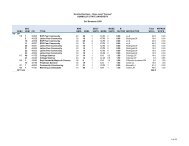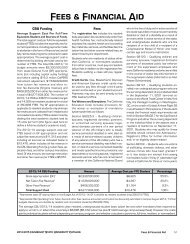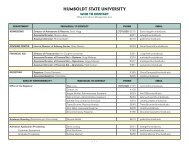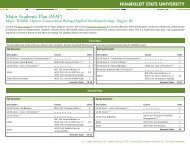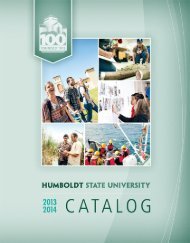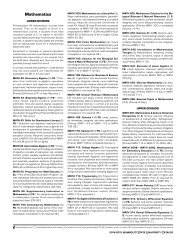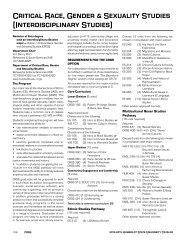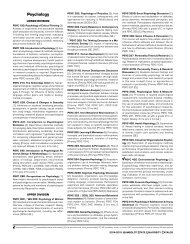2011-12 Academic Year - Bad Request - Humboldt State University
2011-12 Academic Year - Bad Request - Humboldt State University
2011-12 Academic Year - Bad Request - Humboldt State University
You also want an ePaper? Increase the reach of your titles
YUMPU automatically turns print PDFs into web optimized ePapers that Google loves.
Fisheries Biology<br />
Bachelor of Science degree with a<br />
major in Fisheries Biology — with the<br />
following options:<br />
Fresh water Fisheries<br />
Marine Fisheries<br />
Minor in Fisheries Biology<br />
See Natural Resources for information on<br />
the Master of Science degree.<br />
Department Chair<br />
Gary L. Hendrickson, Ph.D.<br />
Department of Fisheries Biology<br />
Fisheries & Wildlife Building 220<br />
707-826-3953<br />
www.humboldt.edu/fisheries<br />
The Program<br />
Students completing this program will have<br />
demonstrated:<br />
understanding of physical and ecological<br />
elements and processes sustaining commercial,<br />
recreational and nongame fish<br />
species, and recognize the implications of<br />
altering those components; application of<br />
conservation principles in developing conservation<br />
approaches for fishes; and incorporation<br />
of social (e.g. laws and regulations) and<br />
economic information in developing fish<br />
conservation plans<br />
a suite of field, laboratory, and computerbased<br />
techniques for studying and managing<br />
fishes and appropriate use and application<br />
of these techniques<br />
the ability to convey scientific concepts in<br />
written, oral, and visual communication formats,<br />
including following basic guidelines for<br />
format and structure of scientific reports,<br />
papers, or presentations<br />
the ability to transform fisheries problems<br />
into mathematical/numeric/statistical<br />
representations (e.g. generate hypotheses);<br />
production of tabular and graphic<br />
summaries of quantitative data; performance<br />
of simple tests of statistical hypotheses<br />
the ability to independently learn through<br />
extracurricular activities and independent<br />
study opportunities<br />
development of scientifically defensible<br />
conclusions of their own work and evaluation<br />
of the work of others for scientifically valid<br />
conclusions.<br />
The overall goal of the Fisheries Biology<br />
Program is to provide students with the<br />
knowledge, skills and motivation required to<br />
ensure the conservation of fish and aquatic<br />
resources that are faced with increasing<br />
societal demands and increasing loss of<br />
habitat. We stress development of a fieldbased<br />
understanding of the relationships<br />
between freshwater and marine fishes and<br />
the habitats upon which they depend, but<br />
our program is broad enough to provide<br />
specialized training in fish population dynamics<br />
and fishery management, restoration<br />
ecology, systematics, marine and freshwater<br />
aquaculture, fish health management, water<br />
pollution biology and wastewater utilization.<br />
Each of these areas has its own important<br />
role to play in the overall conservation of<br />
fish resources.<br />
Fisheries Biology students have on-campus<br />
facilities for hands-on studies: a recirculating<br />
freshwater fish hatchery, rearing ponds,<br />
spawning pens, and modern laboratories for<br />
study of fish genetics, pathology, taxonomy,<br />
ecology, and age and growth. Also on campus<br />
is the California Cooperative Fishery<br />
Research Unit, supported by both state<br />
and federal government, and a large fish<br />
museum collection.<br />
Off campus, students take classes and carry<br />
out research projects at the university’s<br />
marine laboratory in Trinidad, about <strong>12</strong><br />
miles north of campus. A 90’ <strong>University</strong>owned<br />
ocean-going vessel, docked in Eureka,<br />
is available for classes and for faculty and<br />
graduate student research in nearshore<br />
ocean waters. Numerous small boats and a<br />
specialized electrofishing boat are available<br />
for instruction and research in local bays,<br />
lagoons and estuaries.<br />
Our graduates may qualify for certification by<br />
the American Fisheries Society as Associate<br />
Fisheries Scientists, and many continue their<br />
education after HSU, receiving MS or Ph.D.<br />
degrees in fisheries biology or other closely<br />
related fields.<br />
Possible careers: aquarium curator, aquatic<br />
biologist, biological technician, environmental<br />
specialist, fish culturist, fish health manager,<br />
fisheries biologist, fisheries consultant, fisheries<br />
modeler, fisheries statistician, hydrologist,<br />
museum curator, reservoir manager,<br />
restoration ecologist, sewage treatment<br />
water analyst, water quality advisor.<br />
Preparation<br />
We recommend that high school students<br />
interested in Fisheries Biology take as many<br />
challenging biology, chemistry, mathematics<br />
and computer classes as possible, and that<br />
they also stress oral and written communications.<br />
REQUIREMENTS FOR THE MAJOR<br />
Shared Requirements for Freshwater<br />
Fisheries and Marine Fisheries Options<br />
Lower Division<br />
BIOL 105 Principles of Biology<br />
CHEM 107 Fundamentals of Chemistry<br />
CHEM 328 Brief Organic Chemistry<br />
FISH 110 Introduction to Fisheries<br />
MATH 105 Calculus for the Biological<br />
Sciences & Natural Resources<br />
STAT 109 Introductory Biostatistics<br />
ZOOL 110 Introductory Zoology<br />
PHYX 106 College Physics:<br />
Mechanics & Heat, or<br />
GEOL 109 General Geology<br />
Upper Division<br />
FISH 310 Ichthyology<br />
FISH 311 Fish Physiology<br />
FISH 380 Techniques in Fishery<br />
Biology<br />
FISH 460 Principles of Fishery<br />
Management<br />
FISH 495 Senior Fisheries Seminar<br />
FISH 314 Fishery Science<br />
Communication<br />
One genetics course from:<br />
BIOL 340 Genetics<br />
BIOL 345 Genetics with<br />
Population Emphasis<br />
FISH 474 Genetic Applications<br />
in Fish Management<br />
One quantitative course from:<br />
STAT 333 Linear Regression Models/<br />
ANOVA<br />
STAT 406 Sampling Design & Analysis<br />
STAT 409 Experimental Design and<br />
Analysis<br />
STAT 504 Multivariate Statistics<br />
FISH 450 Introductory Fish<br />
Population Dynamics<br />
or an approved upper division quantitative<br />
course<br />
Additional Upper Division Requirements:<br />
Freshwater Fisheries Option<br />
FISH 320/FISH 320L Limnology<br />
FISH 370 Aquaculture<br />
FISH 430/FISH 430L Ecology of<br />
Freshwater Fishes<br />
FISH 443 Problems in Water<br />
Pollution Biology<br />
FISH 485 Ecology of Running<br />
Waters<br />
ZOOL 316 Freshwater Aquatic<br />
Invertebrates<br />
<strong>12</strong>4 Fisheries Biology<br />
<strong>2011</strong>-20<strong>12</strong> <strong>Humboldt</strong> <strong>State</strong> <strong>University</strong> Catalog



